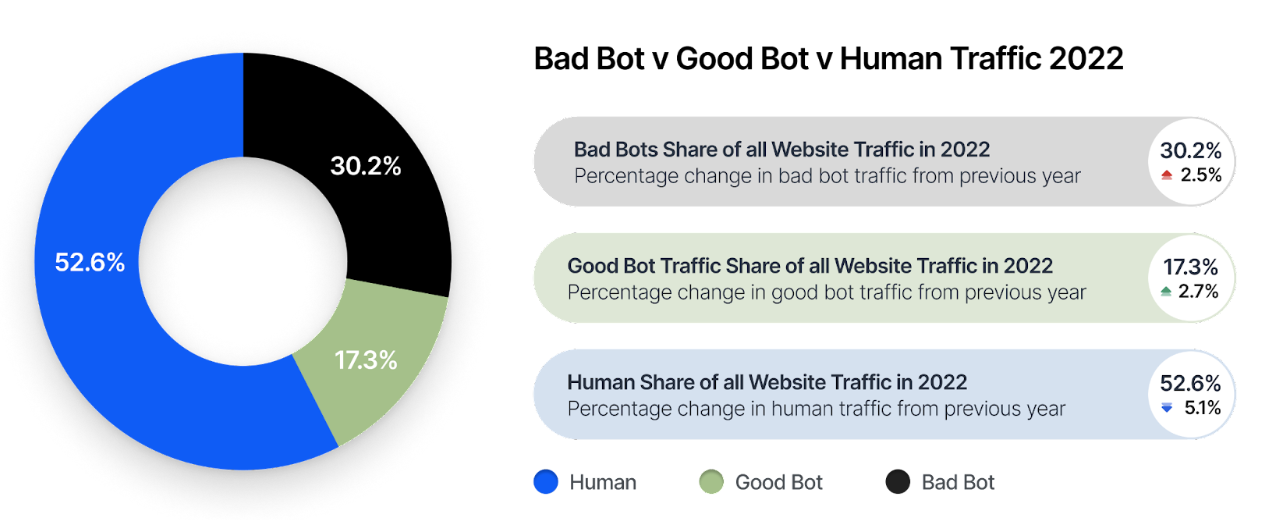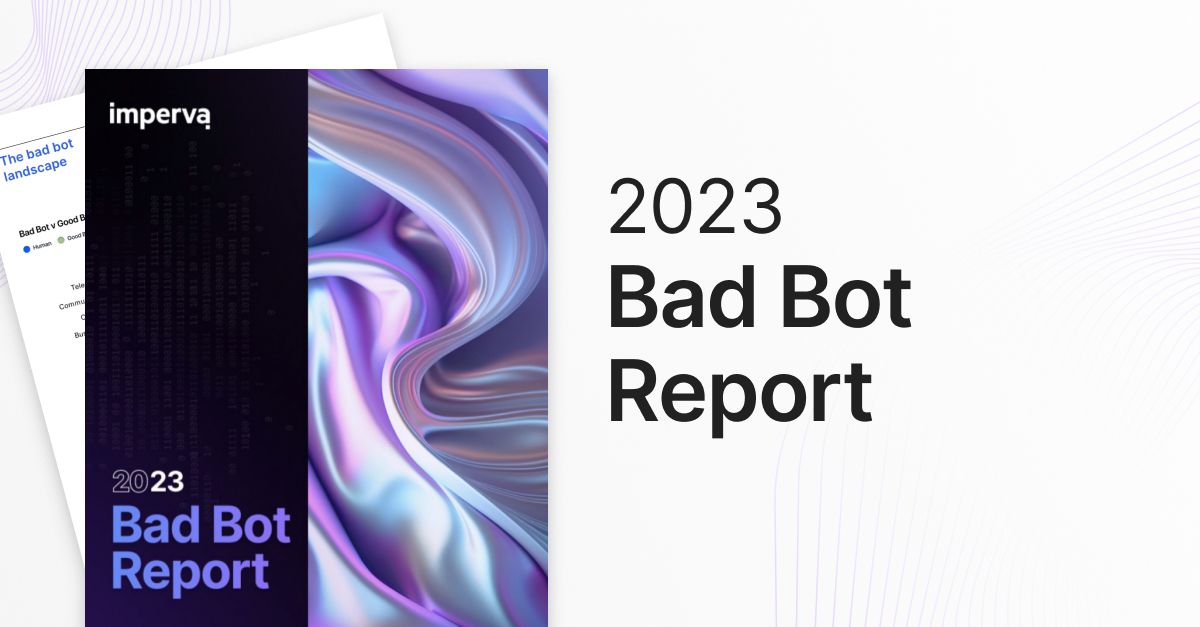The 2023 Imperva Bad Bot Report is now available. The 10th edition of the annual report takes a deep dive into the latest bad bot statistics and trends from the past year, providing meaningful information and guidance about the nature and impact of bots.
Understanding the risks of unmanaged bot traffic
This report helps organizations better understand the potential risks of unmanaged bot traffic. As a leader in bot management, with over 12 years of experience fighting bad bots, this report takes a retrospective look at bots over the past decade.
It covers the evolution of malicious automation, including data about the trend of bot traffic throughout the past decade, as well as some of the biggest stories from previous bad bot reports. These statistics and stories have shaped the bad bot threat landscape as we know it today.
Bot traffic in 2022: a significant increase
In 2022, nearly half (47.4%) of all internet traffic came from bots, a 5.1% increase over the previous year.

Key findings from the 2023 Imperva Bad Bot Report:
Four years of rising bad bot traffic levels
30.2% of the internet traffic in 2022 was bad bots, a 2.5% increase from 27.2% in 2021. Good bot traffic levels increased too, accounting for 17.3% of traffic. And while their name might suggest that they are no cause for concern, these good bots can mean trouble too. They can skew web and marketing analytics, making it extremely difficult for organizations to make informed business decisions.
Bad bot sophistication continues to rise
Advanced bad bots account for more than half of bad bot traffic. In 2022, evasive bad bots accounted for 66.6% of all bad bot traffic – a slight increase from the previous year (65.5%). We often group moderate and advanced bad bots together and refer to them as evasive bad bots, because they represent the more “self-conscious” bots, which go to greater lengths to hide their true identity. While the increase isn’t substantial, it is the makeup of evasive bad bots that is alarming, with advanced bad bot levels essentially doubling in proportions at the expense of moderate ones. The proportion of bad bots classified as “simple” has remained relatively in stasis, as they accounted for 33.4% compared to 34.4% in 2021. Put simply, the proportion of evasive bad bots compared to simple bad bots has remained fairly similar, but these evasive bad bots are getting much more sophisticated.
APIs are a prime target for bad bots in 2022
17% of all attacks on APIs were bad bots abusing business logic, and 21% were other types of automated threats. A business logic attack exploits flaws in the design and implementation of an API or application with the intent of manipulating legitimate functionality to steal sensitive data or illegally gain access to accounts. Furthermore, 35% of account takeover attacks recorded by Imperva in 2022 specifically targeted APIs.
Growth in Account Takeover attacks: a consequence of data breaches
Attacks have grown by 155% between 2021 and 2022. During Q3 2022, we observed a direct correlation between data breaches and account takeover attacks. A reported 70% rise in data breaches across the globe corresponded to a 40% increase in account takeover attacks that were recorded by Imperva at the exact same time. This correlation results from attackers’ attempts to utilize leaked credentials from recently disclosed data breaches before users have time to realize their data has been exposed.
Mobile Safari impersonators: a significant portion of bad bot traffic
This isn’t by chance; we now know that the improved user privacy settings offered by this browser are being exploited by bots to mask their behavior, which makes them even harder to detect. The browser’s user privacy settings limit the number of attributes the browser reports to the origin, thus making bots harder to distinguish from human clients. Bot operators have realized that, and are now abusing this set of features that were designed to benefit the privacy of legitimate users to hide their true identities.
Bad bots: a universal problem across industries and functions
Travel (24.7%), Retail (21%), and Financial Services (12.7%) experienced the highest volume of bot attacks. Meanwhile, Healthcare and Law & Government experienced a considerable jump in the volume of bad bot attacks in 2022. Gaming (58.7%) and Telecommunications (47.7%) had the highest proportion of bad bot traffic on their websites and applications.
Get the full report for all the latest statistics and trends covering bad bot activity. Tune into the webinar, Bad Bots: Balancing Protection Against Customer Experience, to learn how to mitigate automated attacks without impacting the customer experience.
Stop bad bots and online fraud with Imperva
The market-leading Imperva Advanced Bot Protection prevents bot operators, attackers, unsavory competitors, and fraudsters from abusing, misusing, and attacking your applications. It safeguards businesses from today’s most sophisticated bot attacks by protecting websites, mobile apps, and APIs against every OWASP automated threat. Advanced Bot Protection embraces a holistic approach, combining the vigilant service, superior technology, and industry expertise needed to enable customers with full visibility and control over human, good bot, and bad bot traffic, offering multiple response options for each. Most importantly, it does so without imposing unnecessary friction on legitimate users, maintaining the flow of business-critical traffic to your applications.
Advanced Bot Protection is part of the market-leading Imperva Application Security Platform. Start your Application Security Free Trial today to protect your assets from automated threats.
Try Imperva for Free
Protect your business for 30 days on Imperva.












